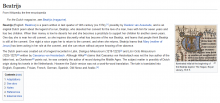Review, translate and summarise the Dutch National Library’s statistics procedures into English, https://nl.wikipedia.org/wiki/Wikipedia:GLAM/Koninklijke_Bibliotheek_en_Nationaal_Archief/Resultaten as we (Sandra and David) think they are of interest to other GLAMs and GLAM-wikimedians.
The purpose is also to compare them with what other GLAMs have reported as their needs in regards to a statistics solution for content on the Wikimedia platforms.
This ticket is part of WMIL's development of a prototype GLAM Statistics Dashboard. (WMIL doesn't use Phabricator so only my small advisory role in that project will be reflected here!)

